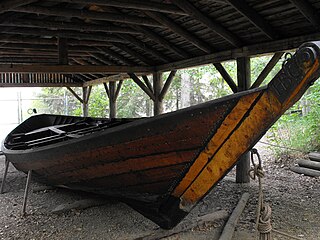 W
WLake Winnipeg is a very large, relatively shallow 24,514-square-kilometre (9,465 sq mi) lake in North America, in the province of Manitoba, Canada. Its southern end is about 55 kilometres (34 mi) north of the city of Winnipeg. Lake Winnipeg is Canada's sixth-largest freshwater lake and the third-largest freshwater lake contained entirely within Canada, but it is relatively shallow excluding a narrow 36 m (118 ft) deep channel between the northern and southern basins. It is the eleventh-largest freshwater lake on Earth. The lake's east side has pristine boreal forests and rivers that were in 2018 inscribed as Pimachiowin Aki UNESCO World Heritage Site. The lake is 416 km (258 mi) from north to south, with remote sandy beaches, large limestone cliffs, and many bat caves in some areas. Manitoba Hydro uses the lake as one of the largest reservoirs in the world. There are many islands, most of them undeveloped.
 W
WSS Colvile was a Lake Winnipeg steamboat built for the Hudson's Bay Company in Grand Forks, Dakota Territory. Colvile was constructed, using some parts of the vessel called Chief Commissioner which in turn used a boiler taken from Anson Northup. Colvile was one of the largest vessels constructed for the HBC. The company hired Captain J. Reeves to supervise the construction of the vessel.
 W
WGeorge Island Light is a lighthouse located on George Island that lies in the middle of the North Basin of Lake Winnipeg in the Canadian province of Manitoba. It is located approximately 400 km (250 mi) north from Winnipeg, and approximately halfway between the shore communities of Grand Rapids and Poplar River.
 W
WHecla-Grindstone Provincial Park includes Hecla Island, Grindstone, Black Island and a number of other small islands in Lake Winnipeg, one of the largest freshwater lakes in the world. The park lies adjacent to the northeast side of the Municipality of Bifrost – Riverton in Manitoba, Canada.
 W
WThe SS Keenora is a steamboat on Lake Winnipeg. The vessel began operations on Lake of the Woods in Ontario, where from she was transported to Winnipeg, Manitoba and rebuilt. Currently retired from service, Keenora is the centrepiece of collection at the Marine Museum of Manitoba in Selkirk, Manitoba.
 W
WIn the last 30 years Lake Winnipeg has experienced a steady surge of blue-green algae growth and although algae grows naturally in the lake, excessive blue-green algae blooms are caused by high ratio levels of nitrogen and phosphorus draining into the lake via rivers and surface runoff. Up to five and a half million people rely on the health of Lake Winnipeg. The lake is an economical powerhouse that supports a $100 million a year tourism industry and a $25 million a year fishing industry. Healthy algae populations play an important role in keeping lake Winnipeg's ecological systems balanced. Green algae provides food for zooplankton, which are then eaten by larger fish in the lake. However the toxins that blue-green algae release can destroy fresh water ecosystems and can be dangerous for humans and other species. Very high levels of the algae toxin microcystin closed Victoria Beach off from the public in the summer of 2003. Grand Beach and other surrounding settlements along the lake are often closed for a short time during summer months due to E. coli and algae-toxin related threats. Immense algae blooms have appeared in the northern part of Lake Winnipeg in the last decade with hundreds of square kilometers of the lake covered with a thick toxic layer of blue-green algae. Local residents in surrounding communities say the blue-green algae is well known for creating deadly water conditions in prairie dugouts and have been known to even kill livestock. Commercial and aboriginal fishermen on the lake often find their nets temporarily disabled during the summer months because of the thick algae conditions. The Lake Winnipeg algae blooms are considered the worst algae problem of any large freshwater lake in the world.
 W
WThe MS Lord Selkirk II was a passenger cruise ship that sailed the Red River and Lake Winnipeg in Manitoba, Canada. Lake Winnipeg's last cruise ship, she was the largest ever built between the Great Lakes and the Rockies, with accommodation for 130 passengers and 40 crew. She was 176 feet long with a 41 foot beam.
 W
WThe Warren Landing Lower Range Lights are a pair of range lights in Warren Landing, Manitoba, at the entrance to the Nelson River. Built in 1908, the lighthouses help to guide ship traffic from Lake Winnipeg into the river. They work in tandem with the Warren Landing Upper Range Lights.
 W
WThe Warren Landing Upper Range Lights are a pair of range lights in Warren Landing, Manitoba at the entrance to the Nelson River. Built in 1908, the lighthouses help to guide ship traffic from Lake Winnipeg into the river. They work in tandem with the Warren Landing Lower Range Lights.
 W
WWarren Landing is a small community in Manitoba, Canada. It is located at the northern end of Lake Winnipeg on Big Mossy Point, where the Nelson River originates.
 W
WThe York boat was a type of inland boat used by the Hudson's Bay Company to carry furs and trade goods along inland waterways in Rupert's Land, the watershed stretching from Hudson Bay to the eastern slopes of the Rocky Mountains. It was named after York Factory, the headquarters of the HBC, and modeled after the Orkney yole. Two variations to the York Boat were scows and "Sturgeon Heads."